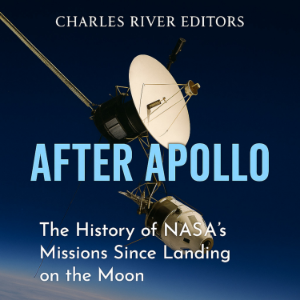

After Apollo: The History of NASA’s Missions Since Landing on the Moon
Charles River Editors
Today the Space Race is widely viewed poignantly and fondly as a race to the Moon that culminated with Apollo 11 “winning” the Race for the United States. In fact, it encompassed a much broader range of competition between the Soviet Union and the United States that affected everything from military technology to successfully launching satellites that could land on Mars or orbit other planets in the Solar System. Moreover, the notion that America “won” the Space Race at the end of the 1960s overlooks just how competitive the Space Race actually was in launching people into orbit, as well as the major contributions the Space Race influenced in leading to today’s International Space Station and continued space exploration.
Space exploration was always an expensive business, and throughout NASA’s history, the agency has had to justify to Congress its need for every dollar it intended to spend. This problem has helped NASA to be more careful and more creative with the money they did receive, and scientists had to justify the equipment they wanted to include on each space probe. They had to justify the size and the power demand, too. If they wanted too much, the entire mission might be scrubbed, and all their work would have been for naught. This made planning and designs leaner and more efficient, as scientists and engineers were more careful with their recommendations.
Although Apollo 11’s successful mission to the Moon is seen as the culmination of the Space Race, and the Apollo program remains NASA’s most famous, one of the space agency’s most successful endeavors came a few years later. In fact, the Pioneer program was the most diversified sequence of any of NASA’s programs, and though they’re now remembered for being among the first probes in history to reach the Outer Solar System, the elaborate planning changed goals several times over several years before resulting in historic successes.
Duration - 11h 11m.
Author - Charles River Editors.
Narrator - Bill Caufield.
Published Date - Sunday, 12 January 2025.
Copyright - © 2025 Charles River Editors ©.
Location:
United States
Description:
Today the Space Race is widely viewed poignantly and fondly as a race to the Moon that culminated with Apollo 11 “winning” the Race for the United States. In fact, it encompassed a much broader range of competition between the Soviet Union and the United States that affected everything from military technology to successfully launching satellites that could land on Mars or orbit other planets in the Solar System. Moreover, the notion that America “won” the Space Race at the end of the 1960s overlooks just how competitive the Space Race actually was in launching people into orbit, as well as the major contributions the Space Race influenced in leading to today’s International Space Station and continued space exploration. Space exploration was always an expensive business, and throughout NASA’s history, the agency has had to justify to Congress its need for every dollar it intended to spend. This problem has helped NASA to be more careful and more creative with the money they did receive, and scientists had to justify the equipment they wanted to include on each space probe. They had to justify the size and the power demand, too. If they wanted too much, the entire mission might be scrubbed, and all their work would have been for naught. This made planning and designs leaner and more efficient, as scientists and engineers were more careful with their recommendations. Although Apollo 11’s successful mission to the Moon is seen as the culmination of the Space Race, and the Apollo program remains NASA’s most famous, one of the space agency’s most successful endeavors came a few years later. In fact, the Pioneer program was the most diversified sequence of any of NASA’s programs, and though they’re now remembered for being among the first probes in history to reach the Outer Solar System, the elaborate planning changed goals several times over several years before resulting in historic successes. Duration - 11h 11m. Author - Charles River Editors. Narrator - Bill Caufield. Published Date - Sunday, 12 January 2025. Copyright - © 2025 Charles River Editors ©.
Language:
English
Opening Credits
Duration:00:00:08
Introduction
Duration:00:20:50
The Early Pioneers
Duration:00:36:51
Heading for the Outer Solar System
Duration:00:38:28
The Concept of a Space Station
Duration:00:11:01
The Design and Construction of Skylab
Duration:00:20:24
Life on Skylab
Duration:00:16:09
The End of Skylab
Duration:00:13:44
Venus Projects
Duration:00:04:30
The Lure of Mars
Duration:00:06:58
Viking's Technical Challenges
Duration:00:09:44
Viking 1 and Viking 2
Duration:01:06:48
The Aftermath of the Viking Program
Duration:00:11:26
Preparations for the Voyager Program
Duration:00:09:22
Voyager 1 and Voyager 2
Duration:00:30:05
The Legacy of the Voyager Missions
Duration:00:07:02
The Origins of the Space Transportation System
Duration:00:16:37
Holding Pattern
Duration:00:37:31
A Major Malfunction
Duration:00:10:58
The Rogers Report
Duration:00:49:31
Building the Hubble Telescope
Duration:00:17:59
Fixing the Telescope
Duration:00:05:31
Producing Results
Duration:01:01:36
Constructing and Launching the ISS
Duration:00:20:47
A Virtual Tour
Duration:00:11:26
Working on the ISS
Duration:00:16:39
Unanswered Questions
Duration:00:09:56
STS-107
Duration:00:22:54
Investigations
Duration:00:24:40
Advanced Components
Duration:00:24:16
Webb at Work
Duration:00:32:14
The Future
Duration:00:05:04
Ending Credits
Duration:00:00:08